|
|
Die Kunst der Fuge BWV 1080
Bach’s Die Kunst der Fuge, Part 1
Recordings
|
1 |
Bach: Die Kunst der Fuge [A-4] |
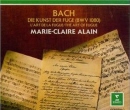 |
|
Die Kunst der Fuge BWV 1080 |
|
Marie-Claire Alain
(Organ) [1975 Kern] |
|
Erato |
Sep 1992 |
CD / TT: |
|
Recorded at Eglise Saint-Martin à Masevaux, Haut-Rhin,
France.
2nd recording of Die Kunst der Fuge BWV 1080 by M.A. Alain.
Buy this album at: Amazon.com
| Amazon.de
| Amazon.de |
|
3 |
J.S. Bach: Die Kunst der Fuge |
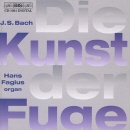
|
|
Die Kunst der Fuge BWV 1080 |
|
Hans Fagius (Organ) [Organ of the Garnisons
Kirke, Copenhagen] |
|
BIS |
Mar 1999 |
CD / TT: 79:50 |
|
Recorded at Garnison Kirke, Copenhagen, Denmark.
Buy this album at: Amazon.com |
|
4 |
Bach: The Art of the Fugue · Die Kunst der Fuge BWV 1080 (excerpts) · Prelude & Fugue on BACH, BWV 898 [K-6] |
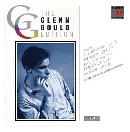
 |
|
1. Die Kunst der Fuge BWV 1080 - Contrapunctus 1-9
2. Die Kunst der Fuge BWV 1080 - Contrapunctus 1, 2, 4, 14
3. Die Kunst der Fuge BWV 1080 - Contrapunctus 9, 11, 13
4. Prelude & Fugue in B flat major on the name BACH, BWV 898 [5:21] |
|
Glenn Gould (Organ) [1] [1960
Casavant]
Glenn Gould (Piano) [2, 3, 4] |
|
Sony |
Jan-Feb 1962 [1]; Nov 1967 [3]; Apr 1980 [4]; Spring 1981 [2] |
CD / TT: 69:36 |
|
Recorded at All Saints' Anglican Church, Toronto, Canada & Chapel of the Theological College, New York City [1]; CBC tevision broadcast, CBC Studios, Canada [2, 3]; Eaton's Auditorium, Toronto, Canada [4].
Includes only the first 9 Contrapuncti on organ; was intended as volume one of a complete recording, which was never finished. Contapuncti 1, 2, 4, 9, 11, 13 14 on piano from later recordings.
Buy this album at: Amazon.com | Amazon.com |
|
5 |
Aldwell Plays Bach [K-4] |

|
|
French Overture in B minor, BWV
831 [28:46]
11 fugues from Die Kunst der Fuge BWV 1080
[44:44] |
|
Edward Aldwell
(Piano) |
|
Biddulph |
Nov 1996 |
CD / TT: 73:47 |
|
Recorded at American Academy of Arts and Letters, New
York, NY, USA.
1st recording of French Overture BWV 831 by E. Aldwell.
Review: Aldwell’s Bach
Buy this album at: Amazon.com |
|
6 |
J.S. Bach: The Art of Fugue · Die Kunst der Fuge BWV 1080
[K-1] |
 |
|
Die Kunst der Fugue BWV 1080 |
|
Evgeni Koroliov
(Piano); Ljupka Hadzigeorgieva (Piano II) |
|
Tacet 13 |
1990 |
CD / TT: 84:46 |
|
Recorded in Frankfurt am Main, Germany.
Buy this album at: Amazon.com
| Amazon.com |
 |
|
9 |
J.S. Bach: Die Kunst der Fuge [A-2] |

|
|
Die Kunst der Fuge BWV 1080 |
|
Kenneth Gilbert (Harpsichord) |
|
Archiv Produktion |
1989 |
CD / TT: 58:41 |
|
2nd recording of Die Kunst der Fuge BWV 1080 by K. Gilbert.
Buy this album at: Amazon.com |
|
10- |
J.S. Bach: Die Kunst der Fuge [A-1] |
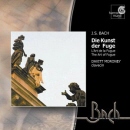
|
|
Die Kunst der Fuge BWV 1080 |
|
Davitt Moroney (Harpsichord) |
|
Harmonia Mundi France |
Jan 1985 |
2-CD / TT: 98:35 |
|
1st recording of Die Kunst der Fuge BWV 1080 by D.
Moroney,. Recorded at Salle Adyar, Paris, France. Included in [B-1]
Buy this album at: Amazon.com | Amazon.com | Amazon.com [Box Set] |
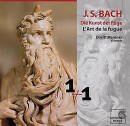
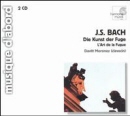 |
|
11 |
Bach: Die Kunst der Fuge (Edition Bachakademie Vol. 134) [A-2] |

|
|
Die Kunst der Fuge BWV 1080 |
|
Robert Hill (Harpsichord); assisted by Michael Behringer on a few tracks |
|
Hänssler |
Jun 1998 |
2-CD / TT: 104:03 |
|
2nd recording of Die Kunst der Fuge BWV 1080 by R. Hill. Recorded at Kirche St. Fides und Markus, Freiburg-Sölden, Germany.
Buy this album at: Amazon.com | Amazon.com |
|
12 |
J.S. Bach: Art of Fugue [A-1] |
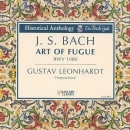 |
|
Die Kunst der Fuge BWV 1080 |
|
Gustav Leonhardt (Harpsichord) |
|
Vanguard |
May 1953 |
2-CD / TT: 86:56 |
|
Recorded in Vienna, Austria.
1st recording of Die Kunst der Fuge BWV 1080 by G. Leonhardt.
Buy this album at: Amazon.com | Amazon.com |
 |
|
15 |
J.S. Bach: Die Kunst der Fuge |
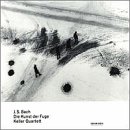
|
|
Die Kunst der Fuge BWV 1080, arranged by William Malloch |
|
Keller Quartett (String Quartet) |
|
András Keller (Violin); János Pilz (Violin); Zoltán Gál (Viola); Ottó Kertész (Cello) |
|
ECM |
May 1997 |
CD / TT: 71:49 |
|
1st recording of Die Kunst der Fuge BWV 1080 by Keller Quartet.
Buy this album at: Amazon.com | Amazon.com |
|
17 |
J.S. Bach: The Art of Fugue - Die Kunst der Fuge |

|
|
Die Kunst der Fuge BWV 1080 |
|
Amsterdam Loeki Stardust Quartet |
|
Daniel Brüggen, Bertho Driever, Paul Leenhouts, Karel van Steenhoven (Recorders) |
|
Channnel Classics |
Apr, Jun 1998 |
CD / TT: 73:05 |
|
Buy this album at: Amazon.com |
|
Donald Satz wrote (December 11, 2000):
There's always much specuation as to Bach's motivation in composing Die Kunst Der Fuge (The Art of Fugue). Was it to for teaching purposes, to display one's craft, or to provide an artistic musical creation within the parameters of the fugue? Whatever the answer, the work can well be used for all three reasons. Additional speculation concerns the proper sequence of movements. A third issue is the merit of recording less than the entire work which is often the case.
The Art of Fugue consists of twenty movements. Most recordings, at a minimum, contain the eleven "traditional" fugues; they are identified as Contrapunctus I thru XI. The additional movements consist of two "mirror" fugues, four two-part canons, two fugues for two claviers, and the Fuga a 3 soggetti.
Seventeen versions are submitted for review:
Organ:
Marie-Claire Alain - Erato 91946 (1992).
Kei Koito - Temperaments 316016/17 (1998).
Hans Fagius - BIS 1034 (1995).
Organ and Piano:
Glenn Gould - Sony 52595 (1962/67/81).
Piano:
Edward Aldwell - Biddulph FLW 002 (1996).
Evgeni Koroliov - Tacet 13 (1990).
Tatiana Nikolayeva - Hyperion 66631/2 (1992).
Joanna MacGregor - Collins 70432 (1995).
Harpsichord:
Kenneth Gilbert - Archiv 427673 (1989).
Davitt Moroney - Harmonia Mundi 901169/70 (1985).
Robert Hill - Hänssler 92134 (1998).
Gustav Leonhardt - Vanguard 2011/12 (1953).
Multiple Instruments:
Rinaldo Alessandrini/Concerto Italiano - Opus 111 30191 (1998).
Savall/Hesperion XX - Astree 2001 (1986).
Keller Quartett - ECM 457849 (1997).
Phantasm - Simax 1135 (1997).
Amsterdam Loeki Stardust Quartet - Channnel Classics 12698 (1998).
Before beginning the reviews, I have four messages:
1. I consider the issue of the sequence of movements entirely moot with the advent of CD technology - program them any way you like.
2. I am not going to be downgrading performances because the work is not provided complete. As an example, Aldwell gives us the 11 traditional fugues; that's it. His coupling is the French Overture. I'm going to evaluate what he provides of the total work. Gould's recording is quite different in that some movements are on organ, others on piano, and three of them are given on both instruments in different versions.
3. Since Contrapunctus I thru XI are the most prevalent items in an Art of Fugue recording, I will review them first, although not always in numerical order. Then I'll cover the additional movements.
4. Any instrument or combination of instruments is quite valid for performance. Bach did not specify instrumentation, although prevalent thinking is that the intent was for the keyboard. For the reviews, I feel I'm offering a decent variety of presentation. The harpsichord is, in my opinion, the most idiomatic instrument. The piano presents a less severe reading. The organ is the majestic and darkest instrument. Multiple instrument performances provide, other matters equal, the greatest variety. I should note that the Channel Classics cd, although multiple in instrumentation, is all on recorders.
The eleven "traditional" fugues can be placed in one of three categories: simple fugues, stretto fugues, or multiple subject fugues. I'll identify the category as we progress from one fugue to the next.
As for possessing any preconceptions, I try to leave those at the door, but I must admit that Gilbert's performance has traditionally been the one I'm most likely to want to hear. The one recording I have not lto at all is the version for recorders from the Amsterdam Loeki Stardust Quartet (ALSQ). To be honest, I am a little skeptical of a group of recorders on a steady basis - I'll see how it works out.
One other thing. I have a very simple rating regimen I generally use:
Level 1 - No desire to listen to it in the future; non-competitive. Level 2 - A worthy performance, but plenty of room for improvement. Level 3 - Very good performance, highly rewarding, blemishes are not major. Level 4 - Excellent performance on both technical and artistic grounds, provides great enjoyment and/or enlightenment. level 5 - Magical and transcendent, doesn't seem that a better version could possibly exist.
Contrapunctus I - All the versions begin with Contrapunctus I which is a "simple" fugue in that there are no special contrapuntal effects; the subject moves from one voice to another. The alto voice introduces the Art of Fugue theme, and it's a lovely and mysterious theme. This fugue presents twelve entries of the subject and twelve answers. The range and intensity of emotions coming out of the music is astounding, and much of it is delivered in a subtle manner. This fugue is so graceful, aristocratic, sad, and urgent that it seems to enter one's bloodstream; the music and the listener are one.
Here's level 1 where Aldwell resides. His reading is very contrary to his usual way with Bach. Instead of being dreamy and slow, Aldwell is relatively fast, misses much of the music's beauty, and bangs out notes toward the conclusion of Contrapunctus I. The other four piano versions are major improvements on this unattractive issue. Kei Koito, on organ, is an even less attractive proposition; she doesn't concern herself with shades of subtlety because her performance contains no subtlety. It's an "in your face" interpretation which I feel is contrary to the themes of the music. Koito also has the annoying habit of changing tempo slightly at inappropriate points.
Gould's organ version occupies level 2. Although a pleasant and enjoyable performance with an attractive bounce, it has the flavor of taking a stroll in the park. I think the music demands greater gravity.
Alain's on level 3 with a dark and well paced performance which excellently conveys the full breadth of emotions. My only reservation is that the sound is bass heavy and somewhat pervasive. Robert Hill delivers a fine and idiomatic performance; it is on the quick side and Hill misses the depth of the best versions. The ALSQ provides a lovely performance on recorders, but there's a weight to the music that's lacking. A lack of sufficient austerity is all that holds back the Savall(all brass), Alessandrini(strings & harpsichord), Fagius and Phantasm(consort style).
Although there are not any magical performances, there are eight outstanding ones: Gould on piano, Gilbert, Leonhardt, Moroney, MacGregor, Koroliov, Nikolayeva, and the Keller Quartett. What they all have in common is that they convey intensely the full range of moods, display a fine projection of twelve entries and answers, provide excellent weight and depth, *and* each performance is flat-out gorgeous. Gould is aristocratic, Leonhardt is slow and inevitable with great build-ups of emotion, Moroney is very urgent, MacGregor is dream-like but serious, Koroliov is exquisitely graceful, Nikolayeva is incisive, and the Keller Quartett is haunting.
At this point, I'm moving on to Contrapunctus III which is the inverse of Contrapunctus I and probably my favorite movement of the Art of Fugue. I feel it has everything that Contrapunctus I possesses plus a great demonic quality as well as being uplifting in nature; the contrast between the demonic and uplifting qualities is stunning. As with Contrapunctus I, III has twelve entries of the subject and twelve answers; however, here the answer comes first. A chromatic and masterful countersubject enhances the wealth of material.
Gould's recording only has an organ version, and it doesn't even rise to the quality of his organ performance of Contrapunctus I. It is too fast and much too light; demonic activities are minimal. The performance of Alessandrini et al employs an oboe d'amore, bassoon, violin, and viola. I don't care much for this combination of instruments for this particular fugue; it lends itself to excessive lightness and the demonic qualities become almost happy and playful. This definitely is not my idea of how to play such intense music. The recorder performance from the ALSQ is also insufficiently heavy to convey the depth of the music, and the recorders sound piercing at times. So these three versions represent Bach "Lite"; you might respond better to this approach than I do.
Robert Hill's reading is highly effective, but his phrasing occasionally does not appeal to me. Phantasm provides a lovely performance, but a comparison with Savall (also all viols) shows the relative lack of weight in their sound. Fagius also has a lack of weight, although I enjoy his version.
That leaves eleven excellent or better versions of Contrapunctus III. The Keller Quartett gives another haunting performance, but I prefer the more demonstrative reading from Savall. Leonhardt is very demonstrative, although Moroney and Gilbert provide more uplifiting interpretations. Nikolayeva's reading is highly enjoyable, but she could have supplied greater emotional depth. MacGregor provides one of the most uplifting performances; the dark side is slightly underemphasized as Aldwell's superbly dark reading clearly shows.
Seven versions are outstanding. Alain and Koito fully deliver from the organ; Alain is very slow with great emotional depth; there are times when it seems as if the bowels of the underworld are opening wide. Koito uses a more moderate tempo to display a very wide range of emotions highlighted by the "all Hell breaks loose" sensation. Savall's Consort reading is a great one - deep with all the weight I could ask for. Gilbert and Moroney give superb harpsichord interpretations highlighting the darkness in the music as well as the optimism. Initially I was a little put off by Aldwell's slow-downs of tempo, but continued listening entirely won me over. Now I had mentioned that Aldwell was quite fast in Contrapunctus I, and his much slower tempo in Contrapunctus III could be seen as a favorable contrast with its inversion. That might hold except for my opinion that Aldwell's strengths in Bach involve slower than average tempos, a relatively seamless flow, and a dream-like atmosphere. I just don't consider Aldwell the type who can well pull off this contrast. Speaking of dream-like peformances, Koroliov starts off in Contrapunctus III with an irresistable dreamy reading; as he progresses he gains weight and strength, providing a great contrast with the first half of his interpretation; the build-up is stunning.
Contrapunctus II is another simple fugue with twelve entries and answers. However, unlike the introspective nature of Contrapunctus I and III, this fugue has a dotted rhythm in the countersubject which gives the music a ceremonial aura similar to a French Overture. The Alain liner notes refer to this fugue as "festive"; personally, I'm hesitant to confer that adjective since the music is, in my opinion, hardly of a highly positive nature. But it is ceremonial and heroic. Stretti and syncopation are also prevalent.
Contrapunctus II has a "galloping" pace. This raises in my mind two questions - where are we galloping towards, and what is the motivation? Of course, that's for each listener to decide (or not).
The ALSQ recorders sound piercing and frankly silly at high volume. At significantly lower volume, the piercing sound disappears. However, the atmosphere is so light, sort of a frolicking gallop. Other listeners might like it, but I find this type of reading somewhat frivolous and not very enjoyable. Performance standards are high, but the interpretation and instrumentation, imho, makes this version non-competitive. Jordi Savall and Hesperion XX are a good antidote to the ALSQ - serious and slow (more on themlater).
Joanna MacGregor is very fast at a little over 2 minutes. She engages in a number of "cute" mannerisms not to my liking which I feel detract from the seriousness of the music. As with the ALSQ, frolicking becomes the overiding activity. Just listen to the Koroliov performance, and you'll notice a large difference in conception. The Keller Quartett is also very quick and sometimes sounds awkwardly played and a bit romantic instead of haunting; my prevailing opinion is that the group handles the fast tempo poorly; they could take a lesson from Gould's fast tempo performance on piano.
The next level up is Phantasm (viols) which uses a less hectic tempo than the Keller Quartett; that's their basic advantage.
Robert Hill is again very good, just missing that last ounce of emotion; also, his gallop is rather choppy. Kei Koito gives a very powerful and intense performance which is slightly unmusical at times. That might well have been intentional on Koito's part as an element of her conception of the movement. Regardless, I think it precludes her version from being excellent; it has a dishelveled quality. That also tends to apply to Marie-Claire Alain's reading as well. I do want to point out that both Alain and Koito sound to me like they are conveying the "Gallop to Hell", and that I feel there is a third version which is in that category and does it significantly better and without losing any musicality (more on that later). Fagius delivers a fine account with less power but greater nuance and lyricism than either Koito or Alain.
Before I hit the excellent performances, I should mention something about the variety of mood in Contrapunctus II. Basically, I feel that the general mood of the music is dark and worse. But there are a few passsages where the light is trying to break in; you know them when you hear them, since they represent such a stark opposition to the majority flavor of the music and because Bach was a master at allowing a subtle but strong shade of mood enhancement in essentially dark music to enter the listener. Well, Contrapunctus II has some of the best uplifting passages he ever wrote. Although I do place top priority on the darkness of this fugue, its uplifting qualities are a very important element as well. These are the excellent readings:
Gustav Leonhardt is on the slow side and highly ceremonial and stately; it's a riveting performance of inevitability. The gallop becomes more of a swagger, and the uplifting passages are well delivered.
Edward Aldwell uses an average tempo and brings more of the uplifting nature of the music to the forefront than any of the other versions. The performance is softer and gentler than most, and it conveys to me the journey toward enlightenment.
Jordi Savall and Hesperion XX give a very haunting performance using a consort approach. They are much slower than the Keller Quartett and Phantasm. Their journey to the ultimate in melancholy is infectious, and the uplifting moments present a very sharp contrast to the general mood of the performance.
I had mentioned earlier that there is a version with a "Galloping to Hell" theme which is excellent; Kenneth Gilbert is going to war. His reading is relentless and intense. He gallops quickly into the fires of Hell to battle the protectors of the underworld; nothing will dissuade him from accomplishing his mission to eradicate all traces of evil and venom. Gilbert's pacing and gallop are probably the best I've heard. He keeps coming at the listener non-stop and without mercy. The uplifting passages are still there and very effective, although their priority is low. My only reservation about the performance is that the level of nuance is very low.
Rinaldo Alessandrini and his Concerto Italiano are fast and galloping toward a state of multiple personalities. Why head in that direction? There's safety in numbers. The counterpoint is stunning, music is going off in all directions but always makes connections at the right moments. Instrumentation consists of strings, bassoon, and harpsichord; they meld together beautifully.
Evgeni Koroliov is racing toward the scene of an impending murder which he dreamed of the previous night, his own. Fortunately, arrival at his destination reveals that he is not dead. Relief is very strong. However, he has the same dream the next night and every one thereafter. Koroliov goes from darkness to light to continual emotional panic - a very effective reading that will actually have you smiling toward the mid-point of the performance.
In discussing the ALSQ peformance, I intimated that Gould's piano performance was an excellent example of how to keep everything in place and moving forward. The man is a technical and artistic marvel in Contrapunctus II. His pacing and accenting are terrific; this is the most exciting of the 18 versions; I dare anyone to stay still while listening. Gould is galloping at lightning speed to the corporate takeover of another conglomerate; it will net him additional billions of dollars, and he's having the time of his life. He exerts power over all, he intimidates everyone, and he can not be cornered. It's a tough world out there.
As good as the above excellent versions are, the following three performances stand above them: Gould on organ, Nikolayeva, and Moroney. Each of them is thoroughly mesmerizing. Gould's pacing and bounce could give a listener the feeling of a light performance, but the bass line has so much impact that a sinister sensation enters the mix. The uplifiting passages come through so clearly and with a rising of happiness which is something to behold. But it's the bass line and bounce which lifts Gould's reading to majestic heights. With Moroney, I have the feeling that his harpsichord is talking to me, and I can't open my mouth to answer. His reading is so authoritative and commanding with the best pacing I've ever heard.
Nikolayeva is ever so slow as she trudges through the snow packed landscape with determined steps. Every inch traversed is analyzed as her head and eyes focus downward to avert the icy sleet hitting her body. She has no real gallop; the environment won't allow it, but the trudging is continuous and strong. She rests, knowing that rest could be the end of her, and she's starting to have visions of better days when she could count on having a tomorrow. But today is all she has. She gets up and continues her journey, but her steps keep getting slower and shorter. Finally, there is no movement; her body sinks into the wet ground, and her spirit finds its way to those better days.
Contrapunctus IV is the inverse of Contrapunctus II. The soprano voice starts things off with the inverted subject. Exuberant extended passages follow, and they need to be projected strongly but also display some fine nuances. Timings range from a little over 2 minutes to a maximum of over seven minutes. This huge tempo differential can greatly change the impact of the music.
The lowest level is reserved for those performances which make this fugue uninteresting. I wouldn't think that would be easy to accomplish, but perhaps I'm wrong. Alain sucks out all interest with a curiously uninvolved reading which is as light as it is uneventful. Koito takes over five minutes to tell me nothing; for this slow tempo to work at all, the counterpoint must be strongly detailed and entries well differentiated from one another. Since Koito doesn't succeed with these basics, her performance just goes on and on. Listen to the equally slow version by Phantasm and hear how capturing the basics gives life to the music.
MacGregor is alone on the second level. Her reading is on the fast side, and that might reduce some of the music's depth. However, she has a larger problem - she plays too softly much of the time with quite a reduction in exuberance. Fast and quiet, in my view, does not get much out of this music. MacGregdoes pick up steam eventually, but it's too late by then. By comparison, Koroliov is even faster but shows that strong projection makes a major difference.
Before moving on to the better versions, I need to point out that Gilbert is a no-show for Contrapunctus IV. The liner notes state that the early manuscript score indicates a total of *three* simple fugues. Based on rules I set up, it's a no harm - no foul situation, although I do find it odd to provide Contrapunctus II but not its inversion.
Hans Fagius is on the third level. His is an heroic and somewhat relentless reading lacking a little in nuance; Moroney, by comparison, is just as relentless but captures all the nuances. Gould, on organ, gives a fine performance which I find slightly lacking in intensity.
There are five excellent versions. Savall's brass performance of heroic proportions is one of them; it's a slow reading of almost six minutes. The ALSQ also gives a great performance of haunting impact. The same applies to the Keller Quartett's fast and exciting interpretation. Aldwell is very rewarding with a smooth performance of depth and beauty. Koroliov gives a Gould-like performance of speed and pin-point accuracy; it's very impressive and maintains fine musicality and variety of expression.
These are the outstanding performances:
Leonhardt's the seven minute man. That he can pull this off at all is fine achievement, but he does much more than that. The stature, depth, tenderness, joy, strong projection, and x-ray examination of every note makes the seven minutes go so quickly. This is magical music-making, must be heard, and is the best version reviewed along with two others.
Gould, on piano, is not as fast as Koroliov, but he's in that ballpark. What lifts Gould to a higher level is the bounce, pacing, and much greater variety of expression than Koroliov provides. This is Gould at his "fast speed" best. Phantasm takes the great potential for a consort reading to deliver a poignant and haunting performance and fully realizes it. Nikolayeva is very incisive; she softens her tone often, but that only inceases the intimacy of the reading; she never sounds as if she's going away. Hill's interpretation is an outstanding one, so full of hope and tenderness.
The second magical performance comes from Gilbert. As good as Hill is, Gilbert delivers that much more incisiveness with a darker reading that still gives full weight to the hope/joy in the music. The tempo is moderate and that might be preferred by most listeners to Leonhardt's very slow account.
Alessandrini and his Concerto Italiano give the third magical performance of Contrapunctus IV. It is easily the most varied and detailed. Flute, oboe d'amore, bassoon, and cello are the intstruments used and each one can be followed with precision as a solo agent and as a piece of the whole. The setting is intimate and joyful in a subtle manner; this is the most uplifting version of the eighteen.
Updates:
I like Moroney's harpsichord versions best in the simple fugues. He is thoroughly idiomatic, and I find myself entirely at one with his intrepretive decisions. He displays great depth, invention, pacing, and a near perfect blend of austerity and joy/optimism.
Excellent performances are from Gilbert, Gould on piano, Koroliov, Nikolyaeva, and Leonhardt. Not far behind are Aldwell, Alessandrini, and Savall.
I have Fagius and the ALSQ toward the bottom of the group. Neither is doing badly, but they have problems. Fagius never rises to the top; he plays well, is enjoyable, and simply does not distinguish himself. With the ALSQ, the problem might be more me than the group. I'm finding them somewhat light and without sufficient variety; the varied and delicious instrumentation of a group like Concerto Italiano is more to my liking. |
| |
|
Continue on Part 2 |
|
|
|